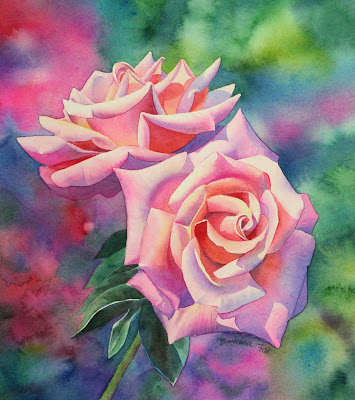Dreamy Pinks
watercolor 9 x 10"
Dreamy Pinks Painting Demonstration
Paints used for this painting: Winsor Newton and M. Graham, Holbein where noted.
Cadmium LemonNew Gamboge
Sap Green
Hookers Green
Peacock Blue (Holbein)
Cobalt Blue
Prussian Blue
Dioxazine Purple
Permanent Rose
Opera (Holbein)
Quinacridone Red
Quinacridone Violet
Alizarin Crimson
Paper I use is Jack Richeson 300 lb cold press watercolor paper.
Here is the photograph I used for reference.
Oops, can't find it. I'll search, then put it in later.
Step 1 - pencil drawing on the paper.
For a complicated drawing like this, I usually do a tracing of my little photograph, then using my copy machine, I enlarge the image and copy this onto my watercolor paper. I hang the drawing on a big. sunny window, tape the wc paper over the drawing, then trace the image.
Step 2 -the color field
I paint in layers, so step one is painting the first layer. I call this my “base layer”, because I am painting the
color of the subject, albeit with some variety. This is done in sections, painting every other petal, for the rose. Let each section dry completely before painting the section next to it., otherwise the colors will run.
A. wetting an area with water, then touching the colors on it,
or
B. laying in a colored wash, then adding the second and sometimes third color.
I used both techniques in this painting. They give the same results.
Remember, the pigments flow with the water, so let the water do the work!
Slowly but surely, the roses are taking shape. I painted the petals using Hookers Green and Pthalo Blue, with Sap Green on the stem.
Don’t be afraid to use rich and/or dark colors in this first step.
When the rose is completely painted with the first layer, and dry, I paint the background, in this case a spotty color field, again painted wet-on-wet. I used Cadmium Lemon, Hookers Green, Peacock Blue, Prussian Blue, Permanent Rose, Opera, and Dioxazine Violet.
Step 3 - Shadows
Once the first layer of color is laid down, I proceed to paint the shadows. Usually the shadows on a flower are the same colors I’ve been using, only darker, and sometimes with a bit of purple (to grey the color) or cobalt blue (to cool the color). These roses are a cool pink, however, the underside of the petals and the interior is very warm- yellows, corals, and oranges. So, for these flowers, I used Dioxazine Violet and Quinacridone Violet to paint the shadows on the outside of the petals, and Alizarin Crimson and Quinacridone Red for the interior of the blossom.
Just as I painted STEP 1, I paint the shadows wet-on-wet, letting the pigments mix on the page.
Step 4- deeper colors
I added drops of water onto the wet pigment here and there. The water pushes the pigment back and creates this out-of-focus mottled effect.
This technique makes very different effects depending on how wet the paper is, so practice it a bit. Also, the pigments react differently, depending on their staining* quality.
*Many watercolor paints are divided into Staining or Granular colors. It is a whole other “science“ of watercolor painting that I don‘t get too involved in. There is probably more information on the Internet, if you’re interested.
When the background was dry, I went over it again with a rich mixture of Peacock Blue. This unifies all the colors and visually pushes back the bright pinks and yellows. We don’t want those competing for attention with the flowers.
Peacock Blue is one of those great colors that seems to layer beautifully over most other colors.
Step 5 -details, details
I use another layer of paint (the same colors) to enhance the colors in the darkest areas, still painting wet-on-wet.I very lightly paint the veins on some of the petals.
Finally I add a small touch of Dioxazine Violet in the very darkest areas.
Voila! A lush and luminous pair of roses!









No comments:
Post a Comment